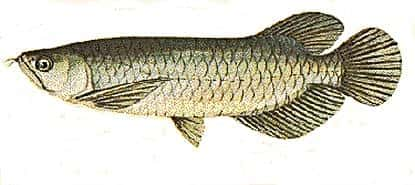Green Arowana – Scleropages formosus – Thai Fish Species
Species: Scleropages formosus
Common name: Green Arowana are also known by other names such as. Asian Arowana and Asian bony tongue or “Dragon Fish´´. These names refer to the same species, known for their beautiful golden coloration and majestic appearance. In various Asian cultures, it is also called the “Lucky Fish” due to its perceived symbolism of wealth, prosperity, and good fortune. Thai Name: Pla Taphat ( ปลาตะพัด )
Distribution: Native to several countries in Southeast Asia. Includes Indonesia, Sumatra, Peninsular Malaysia, Borneo. Thailand, Cambodia, Vietnam and Laos.
Habitat: Includes the following types of environments: slow-moving or still freshwater rivers. They prefer areas with a steady flow of water and often inhabit deeper parts of the river. Arowana are also found in swamps and flooded forests. These environments provide them with abundant food sources, hiding spots, and breeding opportunities. During the rainy season, they may venture into flooded areas, such as flooded forests and wetlands, where they can find food and new territories. Arowana are known to prefer habitats with dense aquatic vegetation and submerged tree roots. They are commonly found in lowland regions, where water levels are relatively stable throughout the year. Some populations of Green Arowana have been introduced into artificial freshwater lakes, ponds, and reservoirs.
 Green Arowana (Scleropages formosus)
Green Arowana (Scleropages formosus)
This is a breathtaking freshwater fish, known for its stunning appearance. As the name suggests, its known for its striking and vibrant colors. It has a distinctive greenish hue on its scales, which can vary in shade from a metallic green to a bluish green. The fins may be a contrasting color, often appearing as shades of red or orange. These fish have large distinctive scales, that are bony and metallic in appearance. These scales reflect light, giving the fish a shimmering and eye-catching appearance. They have an elongated and streamlined body with a slightly arched back. Their body shape shows it to be a powerful swimmer.
The fins of a Green Arowana are long and flowing, especially the dorsal fin, which extends from the middle of its body to the caudal (tail) fin. The pectoral and pelvic fins are also elongated. The mouth is relatively large, adapted for surface feeding, as the fish often preys on insects and other small animals found near the water’s surface. The eyes of the Green Arowana are relatively large and have a striking appearance, further adding to the fish’s overall majestic look. Their striking colors, unique scales, and graceful movements make it one of the most sought-after and prized freshwater fish for aquarium enthusiasts
Cultural significance and demand in the ornamental fish trade
Green Arowana have been introduced to various other countries and regions beyond their native range. However, its introduction to non-native areas has raised concerns about potential ecological impacts on local ecosystems. In the wild, Green Arowana are classified as an endangered species, primarily due to habitat destruction and overfishing. As a result, international trade with Green Arowana is regulated under CITES (Convention on International Trade in Endangered Species of Wild Fauna and Flora) to protect their wild populations.
Green Arowana Lifespan and Size
In the wild, the lifespan of a Green Arowana can be somewhat difficult to accurately determine. Due to various factors such as predation, water quality, availability of suitable prey, and changes in their aquatic ecosystems. As with many species, survival rates and lifespans can vary among individuals and fish populations. However, in their natural habitat, Green Arowana are known to have the potential for longer lifespans compared to those in captivity. It’s generally believed that wild Arowana can live anywhere from 10 to 20 years or possibly even longer under optimal conditions.
The size of Green Arowana can vary depending on factors such as their age, habitat conditions, available food sources, and genetic diversity. In their natural habitats, they can reach larger sizes compared to those in captivity due to the more expansive and diverse environments they inhabit. In the wild, they can grow to lengths of about 2 to 3.5 feet. (60 to 105 cm), including their tails. However, some reports indicate that exceptional individuals have been found measuring up to 4 feet (120 cm) or more. Adult Arowanas can weigh anywhere from 2 to 7 kilograms (4.4 to 15 lbs.) or more, depending on their age and the availability of food. The weight in captivity can vary widely, but they can reach similar weights as their wild counterparts. If they are well cared for and provided with an appropriate diet.
Diet
They have a diverse diet that reflects their status as apex predators in their freshwater habitats. Arowanas are known for their unique hunting behavior called “jar feeding.” They leap out of the water to catch prey that might be perched on low-hanging branches, leaves, or other vegetation above the water. However, fish are a significant portion of the diet, such as smaller cyprinid fish, and minnows. Insects, such as crickets, grasshoppers, and other aquatic insects, are an important part of their diet. Crustaceans, like small crayfish and shrimps. They also feed on small amphibians like frogs and tadpoles, as well as reptiles such as lizards and even small snakes.
Green Arowana Breeding
On average, Arowana start showing breeding behavior and become capable of breeding between 3 to 5 years of age. They are known for their unique breeding behavior. They are mouthbrooders, which means that the male carries and protects the eggs in their mouth until the fry (young fish) are ready to swim freely. During the breeding season, males and females may display increased coloration and become more active. The male selects a suitable territory the female lays her eggs (a few dozen), usually on a flat surface such as a leaf or a root. After the eggs are laid, the male releases sperm over the eggs to fertilize them and the eggs adhere to the chosen substrate.
Once fertilized, the male collects the eggs in his mouth. He carefully picks up each egg and holds them in his mouth. His mouth becomes a safe incubation chamber for the eggs. The male carries the eggs for the duration of the incubation period, which can last for several weeks, depending on the temperature and other environmental conditions. Once the eggs hatch and the fry are ready to swim and feed, the male releases them from his mouth. The fry are usually small and vulnerable, at this stage, as they start to swim in search of food.
Gender
Gender determination of Green Arowana can be challenging, especially when they are young. Unlike some fish species, they do not have clear external differences between male and female. However, there are a few methods that experts and experienced breeders, use to try and determine the sex of adult Green Arowana. Mature males may have slightly larger and more elongated bodies compared to females.
However, this method is not always reliable, as there can be significant variations in size and shape within the same sex. One method used to sex adult Arowana is by examining the breeding tube, a small, fleshy protrusion located near the anal vent. In mature males, the breeding tube is usually more pronounced and pointed, while in females, it is generally more rounded and less visible. Some male Green Arowana may develop an “egg spot” on their anal fin. This is a small, round, white or yellowish marking that resembles an egg. However, not all males will develop an egg spot, and it’s not a guaranteed indicator of gender.
It’s essential to note that gender determination based on physical characteristics can be inaccurate and is not always straightforward. The most reliable method is to observe their behavior during the breeding season. During breeding, males may exhibit more territorial behavior and court females with distinct movements and postures. Determining the sex of young Green Arowana is nearly impossible. As the external differences are not apparent until they reach maturity.
Fishing method
Arowana are surface-dwelling fish and often prefer to feed near the water’s surface. Fish your bait near the surface and allow it to float / Swimme naturally. They primarily feed on small fish, insects, and other aquatic animals. Choose live or artificial bait that closely resembles their natural prey.


 Green Arowana (Scleropages formosus)
Green Arowana (Scleropages formosus)